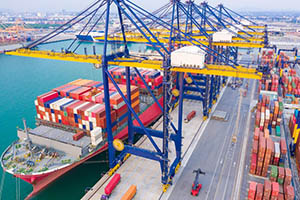Carriage and marine insurance contract
 Goods and other materials exposed to perils of the sea constitute insurable property. If the contract covers the ship, it is called hull insurance and if it covers goods, it is called cargo insurance.
Goods and other materials exposed to perils of the sea constitute insurable property. If the contract covers the ship, it is called hull insurance and if it covers goods, it is called cargo insurance.
The enforcement of the insurance policy comes into play upon occurrence of the risks to which the transported goods are exposed. Before examining the insurer's risk coverage, it is essential to first consider the liability of the carrier, since this plays an obvious role in the event of a claim in terms of the very nature of the contract, its operation and the elements that make it up.
Particularities of a marine insurance contract
Article 1 of the Brussels Convention defines a contract of carriage by sea as evidenced by a bill of lading or similar document standing as document of title for the carriage of goods by sea. In its 1982 report (1), the United Nations Conference on Trade and Development (UNCTAD) emphasized one of the distinctive features of marine insurance, which is its eminently international character:
- Most marine cargo insurance is international in nature, since the carriage of goods by sea is generally international. Thus, the shipper of the goods and the consignee are often different people who are not subject to the same laws and who do not speak the same language. As for the insurer of the goods, it may be based in the shipper's country, in the consignee's country or even in a third country;
- Hull insurance is international, because losses or damage to ships can occur abroad, and also because of the tendency of many shipowners to insure themselves totally or partially in a country other than the one in which they are established.
Many shipowners are, therefore, led to underwrite marine insurance with insurers located in a small number of developed market economies. Shipowners may consequently insure their vessels, for all or part of their value, directly in a third country, even if they have no link with that country other than the insurance contract.
These days, questions of marine law and insurance cannot be examined without clarifying the concepts of liability underlying the carriage of goods. These issues are particularly important when it comes to moving containers or transporting hazardous materials.
Read also | The world merchant fleet
Carriage contract versus charter contract
A distinction must be made between two types of contracts in marine transport: the contract of carriage per se and the contract of affreightment.
The carriage contract
Legally, a contract of carriage is a paid, consensual and synallagmatic contract. In other words, the contract has a price to pay, is consensual (shipper and carrier are parties) and imposes reciprocal obligations on the parties
The contract of carriage is embodied in a specific document, the bill of lading (B/L), which is drawn up between a "shipper" - who may be the exporter or importer, who may be represented by a forwarding agent and the shipping line, usually represented by its agent. Several copies are drawn up for delivery to the parties concerned: the ship's master, the consignee, the shipper and the receiver.
There are different types of bill of lading. The document contains a certain amount of information essential to the smooth running of operations (details of the goods, their consignee, details of the parties involved, name of the carrier, identification of the shipper, etc.).
The bill of lading attests to the formation of the contract of carriage, providing proof that the goods have been taken on board the ship and accepted by the sea carrier.
The charter contract
The chartering contract is embodied in a document known as the Charter Party, an agreement whereby the owner of a vessel (shipowner) rents out their vessel to other persons (charterers) to carry a cargo.
This charter party, an instrument of the charter contract, stipulates the obligations of the parties, spelling out their names, commitments and the characteristics of the vessel. In the charter party, the owner retains control of the vessel's navigation and management, but the charterer is responsible for the cargo. When ships are not used on regular lines, they can be chartered in a variety of ways.
There are three types of charter:
- Bareboat charter, whereby the shipowner provides the vessel to the charterer with no equipment, no crew or a reduced crew; the charterer is then responsible for the vessel's nautical and commercial management;
- Voyage charter: the owner provides the charterer with a specific vessel for one voyage, with the charterer retaining nautical and commercial management of the vessel;
- Time charter: the owner provides the charterer with a vessel for a specific period of time (several months or even several years), with the owner being responsible for the vessel's nautical management and the charterer for its commercial management.
Read also | Ranking of major ports in 2022